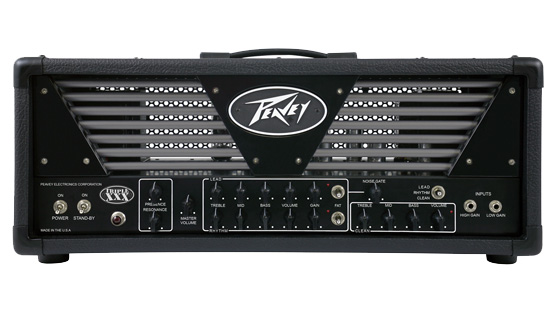Review: Peavey Triple XXX II Amp

Since introducing the VTM Series in the mid Eighties, Peavey has earned a reputation for building fine high-gain amps. The company has rolled out an impressive variety of high-gain models over the years, like the 5150/6505, Triple XXX and JSX. Peavey recently shuffled its amp line around, rebadging the JSX as the Triple XXX II and giving it a significant cosmetic makeover with an arguably cooler V-shaped grille and an undeniably welcome lower price. The Triple XXX II is worth a second look from any guitarist who needs a versatile high-gain amp for the stage and studio.
FEATURES
The Triple XXX II is a 120-watt amp with four EL34s in the power section (6L6 tubes can be installed instead with a bias adjustment) and four 12AX7 tubes in the preamp section. The amp lives up to its name by providing three fully independent channels: Clean, Rhythm and Lead. The Clean channel is exactly that, providing plenty of headroom without even a hint of overdrive. The Rhythm and Lead channels are both high-gain, fire-breathing beasts that start off with aggressive distortion before diving deep into super-saturated sizzle. Each channel has its own volume and set of treble, mid and bass EQ controls (active EQ on the Rhythm and Lead channels), with the Rhythm and Lead channels adding independent gain knobs and fat switches. The Rhythm and Lead channels are routed together through a noise gate, and all of the channels are affected by the presence, resonance and master volume controls.
The amp’s rear panel offers a variety of useful, pro-quality features, including a mono effect loop with independent send and return level controls, bias test terminals, a 1/4-inch line-out jack with its own level control, and a seven-pin DIN connector jack for the included three-switch foot controller that lets you select channels and activate the effect loop. A pair of parallel 1/4-inch speaker output jacks and a four-/eight-/16-ohm impedance switch round out the rear panel’s features.
PERFORMANCE
With its three independent channels, the Triple XXX II is a powerful live performance amp that delivers an impressive variety of clean and distorted tones. The amp tends to skip overdrive, going straight from clean to high-gain distortion, but this is easily remedied by using an overdrive pedal on the Clean channel, a simple solution that allows the Triple XXX II to perform like a four-channel amp. The Clean channel and effect loop offer a solid sonic foundation for any pedal board setup, delivering thick, rich tone and plenty of output volume.
The Rhythm and Lead channels don’t need any additional overdrive or distortion boost, providing more than enough gain for even the most extreme metal and djent tones. The EQ section produces a surprisingly wide variety of tones, from dark-and-dense dirt to razor-sharp sizzle. The fully adjustable noise gate for both channels removes hiss quite well without adversely affecting attack or decay. The Lead channel is perfectly voiced for soloing, providing a smooth, compressed midrange that sings sweetly with seemingly infinite sustain and a dominant voice that cuts through even the densest layers of distorted rhythm guitars.
Get The Pick Newsletter
All the latest guitar news, interviews, lessons, reviews, deals and more, direct to your inbox!
Particularly admirable is the fact that Peavey manufactures this amp in the United States with the high level of quality control expected for a domestic product. What’s really impressive is that the Triple XXX II is priced lower than many comparable amps produced in China and Vietnam, proving that the U.S. can still produce a high-quality, high-value amp here at home. Competing amp companies should take note of how Peavey managed to do this.
THE BOTTOM LINE
With its expressive midrange and incredible ability to cut through a mix, the Triple XXX II is a powerful high-gain amp that’s perfect for soloists as well as players who need versatile tones onstage.
Chris is the co-author of Eruption - Conversations with Eddie Van Halen. He is a 40-year music industry veteran who started at Boardwalk Entertainment (Joan Jett, Night Ranger) and Roland US before becoming a guitar journalist in 1991. He has interviewed more than 600 artists, written more than 1,400 product reviews and contributed to Jeff Beck’s Beck 01: Hot Rods and Rock & Roll and Eric Clapton’s Six String Stories.
"I never use my tube amp at home now, because I have a Spark Live": 5 reasons you should be picking up the Positive Grid Spark Live in the massive Guitar Month sale
“Our goal is to stay at the forefront of amplification innovation”: How Seymour Duncan set out to create the ultimate bass amp solution by pushing its PowerStage lineup to greater heights


![A black-and-white action shot of Sergeant Thunderhoof perform live: [from left] Mark Sayer, Dan Flitcroft, Jim Camp and Josh Gallop](https://cdn.mos.cms.futurecdn.net/am3UhJbsxAE239XRRZ8zC8.jpg)







